George Washington Birthplace National Monument
| George Washington Birthplace National Monument | ||
|---|---|---|
| The replica of George Washington's birthplace | ||
|
|
||
| Location: | Virginia , United States | |
| Next city: | Colonial Beach | |
| Surface: | 2.2 km² | |
| Founding: | January 23, 1930 | |
| Visitors: | 59089 (2005) | |
The George Washington Birthplace National Monument is a replica of the former ancestral home of the Washington family in Westmoreland County of the US state Virginia . George Washington , first President of the United States from 1789 , was born here. The former tobacco farm was declared a National Monument- type memorial in 1932 . The graves of 32 members of the family, including Washington's father , grandfather, and great-grandfather, are also located on the site .
history
Washington's great-grandfather, John Washington , came to Virginia after emigrating from England in 1657 and founded the plantation, which was named Popes Creek, in the former town of Bridges Creek near the confluence of Popes Creek and Potomac River . George Washington's later birthplace was built between 1722 and 1726 by his father Augustine in the middle of the estate. Washington was born here on February 22, 1732, the fifth of a total of ten siblings and lived here until he was three years old. After his father's death in 1743, Popes Creek fell to his half-brother Augustine Washington, junior.
Washington returned to Popes Creek as a teenager to meet Augustine, Jr. to visit, and carried out his first land survey here at the age of 14 . As Augustines, Jr. older brother Lawrence Washington died in 1752 without an heir, Mount Vernon fell to him as heir. Augustine Washington, Jr. However, decided to stay in Bridges Creek, so George Washington inherited Mount Vernon instead. Augustine Washington, Jr. died in 1762. and his son William Augustine inherited Popes Creek, which he henceforth named Wakefield . The actual birthplace, which had since been expanded to ten rooms, was destroyed in a fire at Christmas 1779. It was not rebuilt, and the family moved to the overseer's house a mile away.
In 1815, Washington's step-son and adopted son, George Washington Parke Custis , marked with a memorial stone the place where he believed Popes Creek had once stood. By 1870 the memorial stone had disappeared and the area was used for agriculture. In 1858 the descendants of Washington donated their burial site and the property on which the house where Washington was born to the state of Virginia. The American Civil War put an end to efforts to create a national memorial for the time being. In 1879 and 1881, the US Congress approved funds to honor the birthplace of Washington with a monument. In 1882, Virginia handed over the area donated by the descendants to the federal government, which acquired further shares in the property the following year. In 1893, after another period of inactivity, the US Congress approved the construction of a 50-foot-high obelisk to mark the place of birth. This was built in 1896 on the 38 × 20 foot foundation in which George Washington Parke Custis suspected Popes Creek in 1815.
On June 11, 1923, the Wakefield National Memorial Association was founded with the aim of rebuilding Washington's birthplace and caring for the neglected graves of his ancestors. Now known as the George Washington Birthplace National Memorial Association, the foundation received donations from over 3,000 private individuals, including John D. Rockefeller, Jr. , as well as the federal government and several states. In the 1920s, on the occasion of Washington's imminent 200th birthday, the site came back into the public eye, so in 1926 the US Congress authorized the Wakefield National Memorial Association to build a replica of Popes Creek on the property. It was not possible to erect a building true to the original, as there was no longer an authentic blueprint or illustration. After it was placed under the administration of the National Park Service in January 1930, the American architect Edward W. Donn, Jr. built a so-called Memorial House and a kitchen wing. His focus was on using the rebuilt plantation to illustrate the culture and social position of the Washington, a wealthy and influential family, during Washington’s youth in the 1730s. On May 14, 1932, the buildings and 367 acres of surrounding land were given to the Minister of the Interior in a formal act . Since then, the George Washington Birthplace has been a National Monument.
In 1930 a large foundation was found 50 feet south of the historic kitchen building, which was secured by a full excavation in 1936 and again in 1974 . It turned out that Popes Creek had stood here, and the foundation on which the Memorial House was built must have been an outbuilding, possibly a distillery or a factory. Further excavations revealed findings for a dairy, a small brick building of unknown function, a pile construction, probably the former slave quarters, and the barn in a neighboring field.
Today the memorial houses a museum with over 1000 exhibits to illustrate the US colonial era.
See also
Web links
- National Park Service: George Washington Birthplace National Monument (official site; English)
- George Washington Birthplace Association. In: web presence. Retrieved December 10, 2011 .
Individual evidence
- ↑ Unless otherwise stated, the information is based on From Tobacco Plantation to National Shrine. (PDF 2.66 MB) Loss of the House and Abandonment of the Site. In: George Washington Birth Place website. National Park Service , accessed December 10, 2011 .
- ↑ George Washington's birthday. (PDF 667 KB; MS Word ) In: George Washington Birth Place website. National Park Service , accessed December 10, 2011 .


